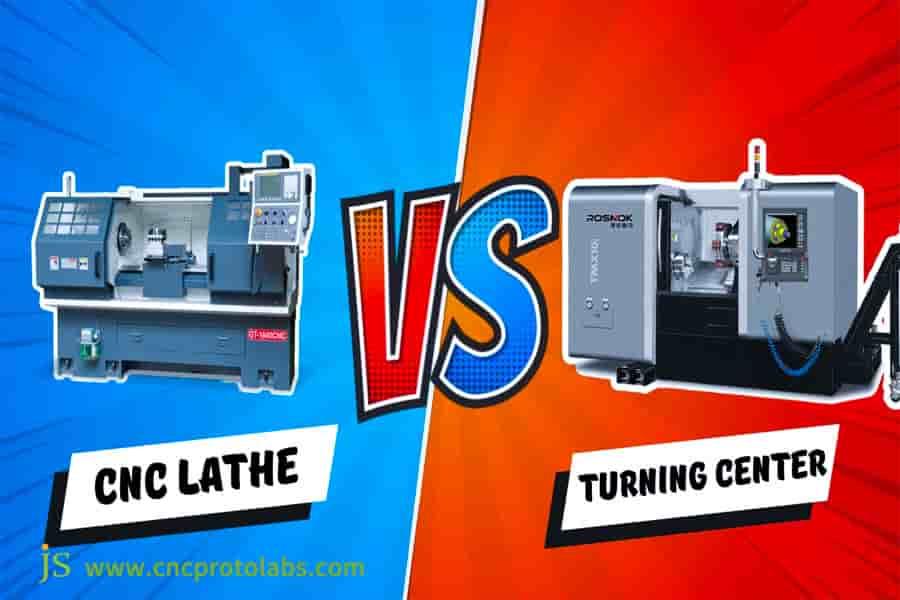In precision manufacturing, every part re-clamping is a risk of inaccuracy, a loss in efficiency, and an addition to cost.
When the parts you machine are no longer simple bushings but require side holes, flattened sections, or specially formed contours, you have to make a critical decision: a less expensive, specialized CNC lathe or a highly integrated, complete CNC turning center machine? This choice directly affects your product's competitiveness.
This article will provide an in-depth analysis and explain why, in the most challenging applications, JS Precision's CNC Turning services are the preferred choice for providing the optimum balance of quality, efficiency, and cost.
Core Answer Summary
| Evaluation Dimensions | Traditional CNC Lathes | JS Precision CNC Turning Centers |
| Machining Philosophy | Separate Process Machining: Turning is the priority, with off-axis features requiring secondary clamping on other machines. | Process Concentration: Complete all or most of the turning, milling, drilling, tapping, and engraving operations in a single setup. |
| Core Capabilities | External turning, internal drilling, threading, grooving, and other rotating body machining. | Full-function turning + live tool milling/drilling + C-axis indexing + Y-axis off-axis machining (optional). |
| Precision Assurance | Excellent precision in a single process, but positional accuracy between features is lost as a result of multiple clampings. | Excellent positional accuracy between features eliminates secondary clamping errors and offers unparalleled consistency. |
| Manufacturing Efficiency | Simple parts offer fast turnaround time, complex parts are burdened with long total cycle time due to many transfers and setups. | Total production cycle time is significantly lower, making it the ideal choice for complex parts with many features and small lots. |
| Management and Management | It is possible to have multiple machines under run, resulting in complicated management and a significant labor cost. | One-stop production eases the process management, saving manpower and floor area. |
| JS Precision Value Infusion | It can be employed on fully turned parts, making it possible to achieve cost-effective solution. | We provide manufacturing solutions coupled with process optimization for cost reduction and improved efficiency directly at the source. |
Why Reliable? JS Precision's Past Project Experience
Reliable experience is important in making selection decisions for machining equipment, and JS Precision's own past experience in CNC turning provides a good basis.
We have been specialized in producing custom CNC turning for the past 15 years, with more than 500,000 CNC turning parts manufactured for over 300 customers in automotive electronics, medical equipment, aerospace, and other industries.In these projects, we optimized the turning manufacturing process and adjusted the processing steps according to different part characteristics, effectively improving production efficiency and yield.
For example, when we were machining titanium alloy implants for a medical customer, we used a CNC turning center to perform turning, grooving, and drilling within one setup, which ruled out cutting problems of material hardening by traditional sequential processes and doubled yield from 85% to 99.5%. On a project on an automotive sensor housing, we reduced lead time by 70% using the multi-processing capability of the turning center.
This is not book data summarization, but our practice in selecting machines while dealing with thousands of complex orders. It will protect you from pitfalls.
JS Precision is a 15-year-old CNC turning facility that has turned over more than 500,000 CNC turning parts and has been providing consistent custom CNC turning manufacturing services. Let us pick the machines appropriately and avoid pitfalls through us.
Unveiling The Fundamentals: Aware Of Their Ancient Characteristics According To The Definition
In order to choose the right equipment, first you need to understand the basic differences between CNC turning objects and CNC turning centers. Their ancient characteristics determine their applications, in turn.
CNC Lathe: To Turn Objects
Definition: CNC lathe is a machine tool that employs a stationary tool in the process of material removal with the assistance of workpiece rotation. It has only the ability to execute axisymmetric geometry such as cones, cylinders, and spheres.
Drawbacks: As CNC lathes need to only machine near the workpiece axis, parts with off-axis holes or flat surfaces to be milled must be turned over to a drill or mill machine for further processing, with added setup time and accuracy susceptibility.In addition, traditional CNC lathes are difficult to adapt to complex turning programs on CNC, and have low programming flexibility in multi process machining.
CNC Turning Center: A Disruptive Multi-Processing Revolution
Definition: A CNC turning center is just a CNC lathe with an added turret-driven and precise C-axis. The workpiece may be placed to be machined and positioned precisely by the C-axis and machine-turned and drilled directly by the turret-driven tool.
Core: It breaks the limits between "turning" and "milling," making it possible to machine complex parts completely on a single machine, without having to be moved to a different machine. This is the most fundamental difference with traditional CNC lathes.
Major Components Of JS Precision Equipment: Unveiling The "Power Source" Of Turning Centers
Major components determine CNC turning centers' complicated machining capabilities. JS Precision turning centers have the optimized major components for the guarantee of machining accuracy and efficiency:
High-rigidity powered turret: An independent "servo electric spindle" is built in every tool station with stable torque and speed. Milling capability is the same as a vertical machining center, and side groove and flat surface machining becomes even more precise.
High-precision C-axis and direct-drive motor: Deliver infinite workpiece rotation and millisecond-level positioning at any angle, the foundation for sophisticated side machining, e.g., angular errors of ≤0.001 degrees when milling circular holes.
Optional Y-axis-A genuine game changer: With vertical tool motion, it allows off-axis machining (e.g., offset holes, asymmetrical contours). This is a key difference between commodity and premium turning centers and is standard on some high-end JS Precision models.
Second spindle (sub-spindle): Enables automated workpiece transfer, allowing a single machine to complete double-sided part machining without manual intervention, achieving complete, "unmanned" manufacturing.
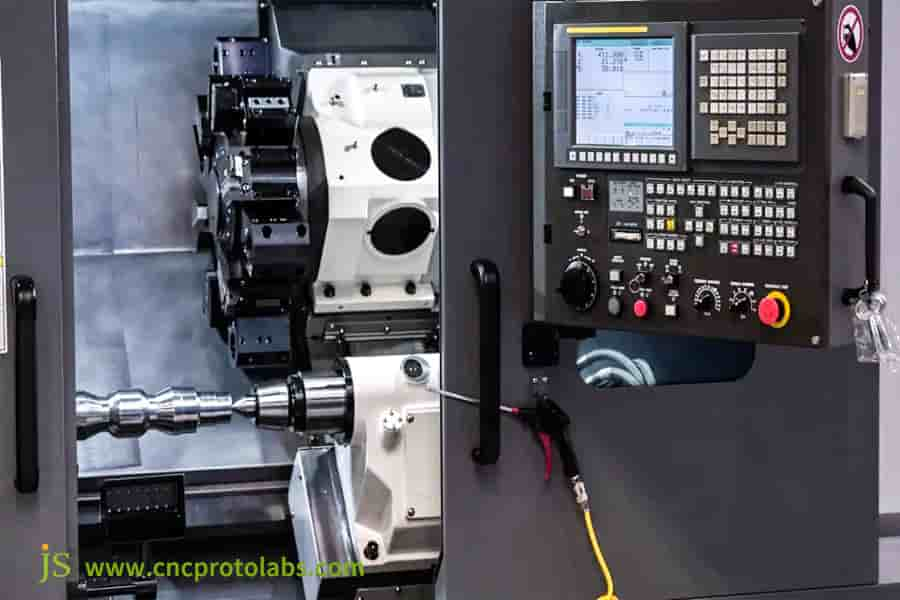
Head-To-Head Comparison: CNC Turning Center Vs. CNC Lathe
Having understood the nature and salient features of each, a comparison of individual dimensions side by side will readily show where they differ and enable you to pick the appropriate one as per your need:
| Comparison Dimensions | CNC Lathe | CNC Turning Center |
| Accuracy and Consistency | Multiple setups can very easily lead to cumulative errors, that is, low positional accuracy between features. | Single setup eliminates cumulative errors, that is, better positional accuracy for all features. |
| Production Efficiency | Fast machining of simple components, fewer tool changes and cutting cycles. | Very good advantage for complex components, no secondary set-ups and commissioning time, 30%-70% shorter cycle times. |
| Labor and Space Costs | Requires multiple machines, more space, and multiple operators. | One machine replaces a "lathe + machining center" station, lower space and labor costs. |
| Operator Skill Requirements | Requires lathe programming and operation skills. | Requires both milling and turning programming combined (e.g., the simultaneous use of G-code and M-code), which is more demanding. |
As is apparent from this comparison, both have their own advantages, and the choice should be made based on part complexity and production requirements. To machine uncomplicated axisymmetric bolts, a CNC lathe is suitable. To machine gear shafts with side holes, a CNC turning center is more suitable.
In addition, our online CNC turning services can generate detailed cost estimation reports for different equipment solutions, helping you visually compare and choose.
This comparison illustrates the obvious advantages of employing turning centers for intricate part machining. JS Precision offers online CNC turning services, with a trade-off between efficiency and cost. Do not hesitate to contact and start the collaborative process.
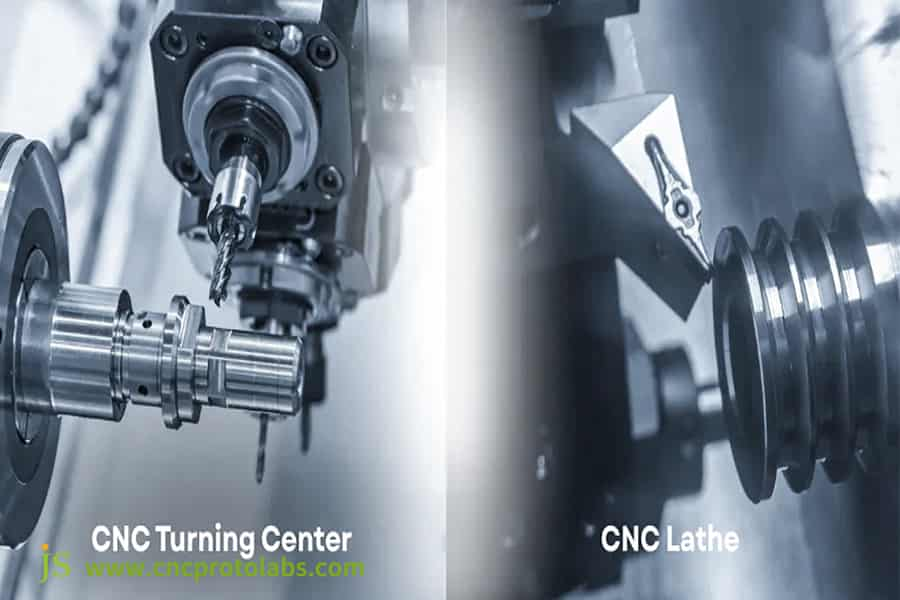
JS Precision's Turning Center Lineup: Determining The Most Suitable Fitting Machining Solution For You
JS Precision offers three types of CNC turning centers to meet different machining needs. You can choose based on part complexity and precision requirement:
1. Cost-Efficient Model: Equipped with live tooling and a C-axis, it can handle most side drilling and slotting applications, e.g., shaft machining with simple side holes. It represents the most cost-effective entry-level solution for advanced machining.The CNC turning price of this model is relatively affordable and suitable for small and medium-sized production.
2. Fully Improved Model: With a second spindle and additional Y-axis included, it gives powerful 3D milling and double-sided machining capabilities. It's best suited for machining high-precision, thin pieces such as medical implants and miniature aerospace parts. It's our bread-and-butter machine.
3. B-Axis Mill-Turning Center: This center is equipped with milling capacity on par with 5-axis machines with a swiveling B-axis head. It's best suited for turning non-rotating components with complex curved surfaces such as specially designed aerospace components. We provide consulting and service for these ultra-high-end processes.
Cost Analysis Beyond Price: Why Are Turning Centers "Cheaper"?
The majority opt against it due to the initial cost of a CNC turning center but the cost per part is less in the long term. Here follows the actual cost breakdown:
Initial Cost: A turning center will be 1.5 to 3 times the cost of a CNC lathe with comparable specifications. For example, a typical CNC lathe would cost around $50,000, while a turning center with comparable specifications would cost between $75,000 and $150,000.
Total Cost Per Part Calculation:
- CNC lathe solution cost = (lathe processing cost + milling/drilling machine processing cost + secondary clamping/transfer time cost + accuracy risk cost). For example, for side hole machining part machining, lathe processing cost is $5 + milling machine processing cost is $3 + clamping and transfer time is $2 + accuracy risk is $1, which comes to a total of $11.
- The total cost of JS Precision turning center solution = (turn-milling combined cost of processing). Cost of processing the same part in the CNC was $8, so $8 per part.
Conclusion: For off-axis features needed parts, common JS Precision's CNC turning center offerings are decreased overall cost per part without secondary clamping, machine occupancy reduction, and process ease. This produces a good ROI by usually recovering the differential purchase price in 2-1 years.
In comparison to JS Precision CNC turning center machine, the investment is higher but the part cost is lower. I can provide you with a precise CNC turning price using your batch quantity of parts. Let me know for sure.
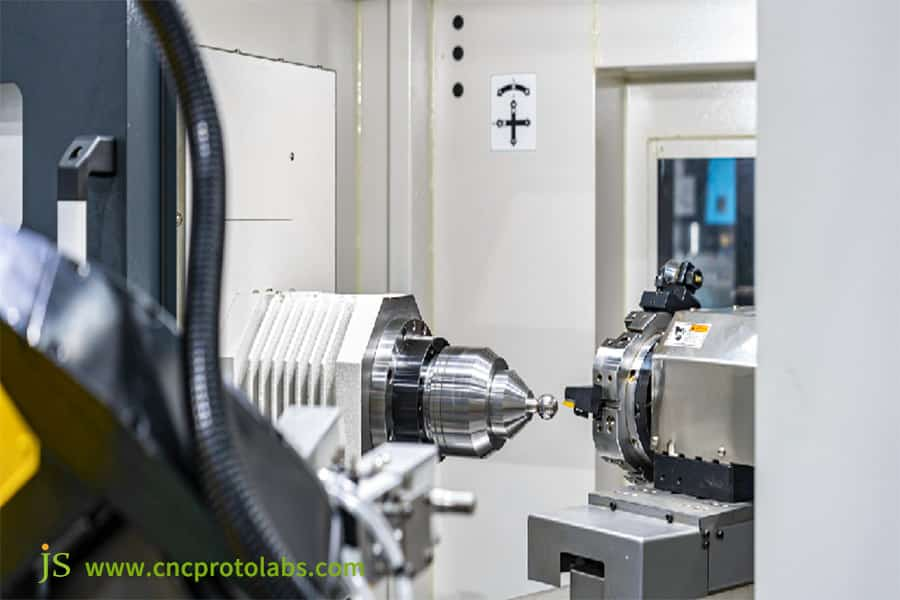
Maximizing Material Performance: Why Can JS Precision Turning Centers Machine A Wider Variety Of Materials?
Materials vary in ease of processing, and thus there is a variation in the ability of CNC turning centers and CNC lathes to process. JS Precision turning centers are superior in machining special materials:
1.Difficult-to-machine materials (such as Inconel and titanium alloy): Machining is completed in one clamping, avoiding chipping and precision drift from repeated work hardening, and enhancing yield by over 30%.
2.Thin-walled parts with material prone to warpage (such as thin-walled aluminum alloy cylinder): Machining is completed in one clamping, avoiding warpage from repeated clampings, which is impossible using traditional sequential machining. Warpage is ≤ 0.002mm.
3.Costly material (e.g., precious metals such as silver and titanium alloy): Minimum near-zero clamping allowance and high accuracy reduce wastage of costly material. As an example, the scrap rate on silver parts was reduced from 5% to less than 1%.
JS Precision CNC turning center machine can perform machining of high-value and hard-to-machine material with assured quality and material usage of CNC turning parts. In case you have special needs for material processing, please get in touch with us for tailored processes.
Decision-Making Process: Selecting The Most Suitable Process For Your Project
If you're still not clear in making the equipment choice, use the following procedure to determine the most effective solution:
1. Determine first if your part is merely axisymmetric and requires just turning. If "yes," the most economical choice is a CNC lathe, for instance, for turning straightforward nuts and bolts.
2. Does your part require off-axis features (e.g., side holes, flats, or face grooves)? Proceed to the next step: Do the off-axis features require high precision? Is the series sufficiently large? If "yes" on both counts, a CNC turning center is an ideal solution, e.g., to turn automotive sensor housings.
3. If your part is a extremely high-volume, axisymmetric part with an extremely simple structure (such as a typical shaft with a production run of over 10,000 units a day), then seek out a Swiss-type machine or a special lathe to increase the efficiency even further.
4. If you frequently switch product types and produce mainly complex, low-volume parts (e.g., more than 10 types per month, 50-100 parts per type), a CNC turning center machine's flexibility will be well worth the investment, eliminating the need for frequent commissioning of multiple machines.
Case Study: How A JS Precision Turning Center Reduced Sensor Housing Delivery Cycle Time By 70%
Most compelling are findings derived from real projects. As an example, let us utilize the sensor housing processing for an automotive electronics client to illustrate the type of transformation that a CNC turning center can bring:
Customer Pain Points
This customer needed to produce an aluminum alloy sensor housing. The original operation was to turn the main body (outside diameter, inside bore, and face) on a CNC lathe, then transfer it to a vertical machining center to mill two side faces and drill a dowel pin hole. The total operation had two setups, two machines, and two programs and took 12 minutes per part to complete.
Moreover, the secondary setup also generated small angular offsets (more than 0.02mm), which resulted in a scrap rate of 8% and consistently delayed delivery dates.
JS Precision Solution
We re-designed the process for the customer, utilizing JS Precision's full Y-axis CNC turning center to complete all machining operations in a single setup. The process step-by-step is as follows:
- Turning all outer circles, inner holes, and end face features of the machined parts, taking 1 minute.
- Rotate C-axis to position the first side face, and then power mill the flat face with a milling cutter, taking 0.8 minutes.
- Rotate C-axis 180 degrees to mill the second symmetrical plane, taking 0.7 minutes.
- Employ the Y-axis offset capability to precisely drill the off-axis locating pin hole, in 1 minute.
- Complete the part and eject it, without any human intervention, in a total of only 3.5 minutes.
Comparison of Results
| Comparison Items | Original Process (Lathe + Machining Center) | JS Precision Turning Center Solution |
| Working Time per Part | 12 minutes | 3.5 minutes |
| Yield | 92% | 99.8% |
| Number of Equipment Involved | 2 units | 1 unit |
| Lead Time | 15 days | 4.5 days |
The figures show that JS Precision's CNC turning center not only saved work time and lead time, but also slashed yield dramatically, which was a vital customer pain point.
JS Precision's high-quality turning manufacturing process successfully trimmed sensor housing lead time by 70%. If you have the same machining challenges, simply submit your project details and we can customize a solution.
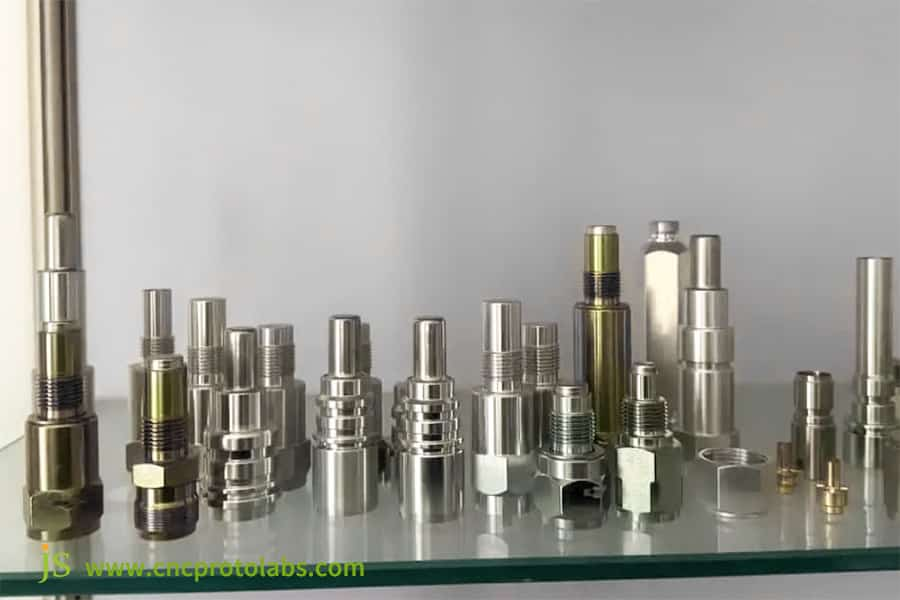
Choose JS Precision, Choose Certainty: Our Value-Added Beyond Equipment
Choosing components is not merely choosing a machine, but choosing a reliable partner. JS Precision not only offers you top-grade quality CNC turning centers and machining operations, but also additional value:
Design for Process Optimization, Starting from Design: Our engineers will assist you throughout the quoting process, providing design-for-manufacturing suggestions from your part's 2D prints and 3D model. They can optimize part configurations for design to leverage the turning center optimally, e.g., removing unnecessary off-axis features and reducing your cost.
Programming Intelligence, the Efficiency Key: Our programing department for mill-turn can develop efficient and stable turning program on CNC to maximize the machine's ability. Another instance is that minimizing the cutting path can again reduce machining time by 10%-15%.
Step by Step Quality, A to Z: From raw materials received (each batch of raw material is compositional analyzed) through to final inspection (critical dimensions are checked against a coordinate measuring machine), we're going step by step according to ISO quality management system controls, so the batch of CNC turning parts you receive is flawless every time.
Effortless and Peace-of-Mind Project Management: Every project has a project manager, with open tracking service available from ordering to delivery. You can always track production status, reducing back-and-forth communication and attaining peace of mind.
FAQs
Q1: If I have a large quantity of straightforward pieces, is a turning center wasting resources?
On high volumes of simplified turned parts (e.g., turning 5,000 typical cylindrical shafts a day), a specific CNC lathe is the more cost-effective route. JS Precision always adheres to the philosophy of "the best fit is the best." We'll give you the best answer, even on less complex CNC lathe work, square and won't mislead you to sell you a turning center.
Q2: Does a turning center machine hexahedrons?
Yes, but limited. Utilizing a series of C-axis indexing and live tooling, a turning center can be designed to cut five faces (e.g., the top, bottom, front, and right faces of a cuboid) and workpiece clamping face. Machining six sides and clamping face requires an upper-level mill-turn center with a second spindle and B-axis. Such advanced solutions can be consultancy and implemented by JS Precision.
Q3: What do I take to work with JS Precision?
Cleaned 3D models (STEP, X_T formats) and 2D drawings are required. These information provide us with a precise definition of part dimensions and accuracy requirements. Also, provide us with the part material, production quantity (e.g., 50, 1,000 units), and surface finish requirements. Our system will return you with a complete quotation together with process analysis and optimization recommendations automatically.
Q4: How do I know JS Precision can make my precision parts?
We encourage you to visit our JS Precision factory and witness the functioning of our CNC turning center machines and our quality checks (e.g., raw material test room, coordinate measurement room). We also give a free first-article tryout run. You can use the accuracy and quality of the first piece to test our ability and surprise you with the result.
Summary
The choice between CNC turning center and CNC lathe is technology and not the issue of millisecond understanding of cost, quality, and efficiency. On every part with off-axis features, JS Precision's custom CNC turning manufacturing service translates into shorter lead time, improved quality consistency, and smaller total management cost.
Now, it's time to test this claim with the most challenging part in your hand.
Let data make decisions for you!
Your drawing today and not only receive a free initial quote but also a "Turning Center vs. CNC Lathe Process Comparison Analysis Report" by JS Precision's engineering team. The report merely presents to you the estimated cost, lead time, and process risk of each alternative, providing you with objective facts that guide you to the most efficient and cost-saving method of production.
Disclaimer
The contents of this page are for informational purposes only.JS Precision Services,there are no representations or warranties, express or implied, as to the accuracy, completeness or validity of the information. It should not be inferred that a third-party supplier or manufacturer will provide performance parameters, geometric tolerances, specific design characteristics, material quality and type or workmanship through the JS Precision Network. It's the buyer's responsibility Require parts quotation Identify specific requirements for these sections.Please contact us for more information.
JS Precision Team
JS Precision is an industry-leading company, focus on custom manufacturing solutions. We have over 20 years of experience with over 5,000 customers, and we focus on high precisionCNC machining,Sheet metal manufacturing,3D printing,Injection molding,Metal stamping,and other one-stop manufacturing services.
Our factory is equipped with over 100 state-of-the-art 5-axis machining centers, ISO 9001:2015 certified. We provide fast, efficient and high-quality manufacturing solutions to customers in more than 150 countries around the world. Whether it is small volume production or large-scale customization, we can meet your needs with the fastest delivery within 24 hours. Choose JS Precision this means selection efficiency, quality and professionalism.
To learn more, visit our website:www.cncprotolabs.com


